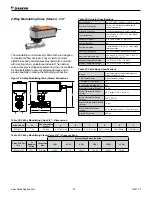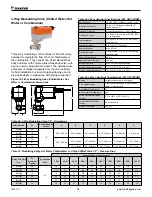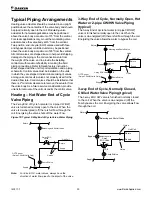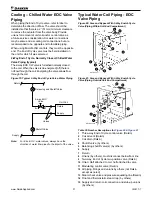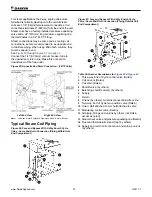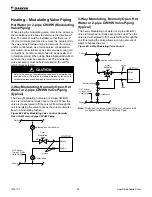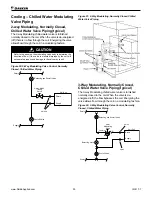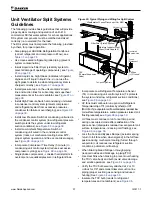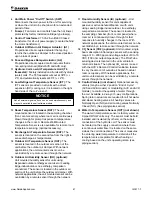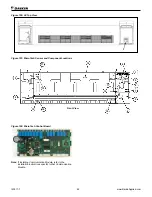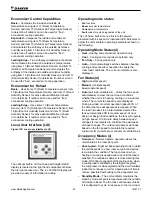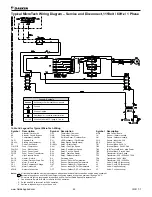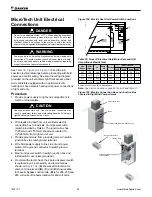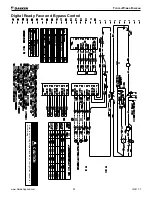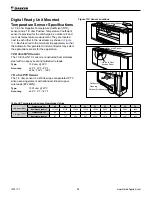
www.DaikinApplied.com 41
IM 817-7
6
Unit Main Power “On-Off” Switch:
(SW1)
Disconnects the main power to the unit for servicing
or when the unit is to be shut down for an extended
period of time.
7
Fuse(s):
Fan motor and controls have the hot line(s)
protected by factory installed cartridge type fuse(s).
8
Control Transformer:
75 VA 24-volt NEC Class 2
transformer for 24 volt power supply. (Located behind
the motor transformer).
9
Outdoor Air/Return Air Damper Actuator: (A1)
Proportional, direct-coupled actuator that spring
returns the outdoor air damper to the closed position
upon a loss of power.
10
Face and Bypass Damper Actuator:
(A2)
Proportional, direct-coupled control actuator that is
non-spring returned (Model AVS and AVB only).
11
Hydronic Coil Low Air Temperature Limit (T6
freezestat):
Factory installed on all units with hydronic
(water) coils. The T6 freezestat cuts out at 38°F (+/-
2°F) and automatically resets at 45°F (+/- 2°F).
12
Low Refrigerant Temperature Sensor (ICT):
The
ICT sensor is provided on all units with a direct
expansion (DX) cooling coil. It is located on the right
hand side of the coil “u-bend”.
NOTICE
Not all external signal options can be used simultaneously and
may not be available on all software models.
13
Room Temperature Sensor (RAT):
The unit
mounted sensor is located in the sampling chamber
(front, center section) where room air is continuously
drawn through for prompt response to temperature
changes in the room. A Remote Wall Mounted
Temperature Sensor is also available for remote room
temperature sensing. (optional accessory).
14
Discharge Air Temperature Sensor
(DAT):
The
sensor is located on the second fan from the right to
sense discharge air temperatures.
15
Outdoor Air Temperature Sensor
(OAT):
The
sensor is located in the outdoor air section of the
unit before the outdoor air damper. With network
applications, the unit mounted sensor can be
overridden by a remote sensor through the network.
16
Outdoor Air Humidity Sensor (OH) (optional):
Unit mounted humidity sensor for units using
Expanded outdoor enthalpy economizer or Leading
Edge indoor/outdoor, true enthalpy comparison
economizer. The sensor is located in the outdoor air
section of the unit before the outdoor air damper. With
network applications, the unit mounted sensor can be
overridden by a remote sensor through the network.
17
Room Humidity Sensor (IH) (optional):
- Unit
mounted humidity sensor for units capable of
passive or active dehumidification or with units
using Leading Edge indoor/outdoor, true enthalpy
comparison economizer. The sensor is located in
the sampling chamber (front, center panel) where
room air is continuously drawn through for fast
response to humidity changes in the room. With
network applications, the unit mounted sensor can be
overridden by a remote sensor through the network.
18
CO
2
Sensor (CO2) (optional):
Unit mounted, single
beam absorption infrared gas sensor with a sensing
range of 0 – 2000 ppm and voltage output of 0 to 10
VDC (100 ohm output impedance). The Pitot Tube
sensing device is located in the unit ventilator’s
return air stream. The optional CO
2
sensor is used
with the UVC’s Demand Control Ventilation feature
to vary the amount of outside air based on actual
room occupancy. With network applications, the
unit mounted sensor can be overridden by a remote
sensor through the network.
19
Control Valve(s) (not shown):
Optional accessory
valve(s) may be either 2 position “End of Cycle”
(AVS and AVB models) or modulating (AVV and AVR
models), to control the quantity of water through
the coil. Available in 2-way or 3-way configurations.
Spring return actuators are required for all hot water
and steam heating valves. All heating valves are
Normally Open (NO) and all cooling valves Normally
Closed (NC). (See piping/valve section)
20
Water In Temperature Sensor (OCT) (not shown):
The water in temperature sensor is factory wired on
2-pipe CW/HW units only. The sensor must be field
installed and insulated (by others) on the supply
connection of the hydronic coil. The sensor must
be located on the supply connection where there
is continuous water flow. It is located on the same
side as the coil connections. The sensor measures
the entering water temperature to determine if the
temperature is acceptable for either heating or
cooling based on the unit’s operating state. (see
piping section)

